HELCOM Expert Group on Coastal Fish
The purpose of the HELCOM Expert Group on Coastal Fish (EG Coastal Fish) is to support the implementation of the Helsinki Convention, including its Baltic Sea Action Plan, and, for those Contracting Parties being EU members, relevant EU legislation (e.g. Habitats Directive and Marine Strategy Framework Directive (MSFD), the EU Strategy for the Baltic Sea Region (EUSBSR), etc.).
EG Coastal Fish aims to support ecosystem-based management of coastal fish communities in the Baltic Sea coastal countries through further developing regionally harmonised monitoring and assessment methodologies, conducting harmonised indicator-based status assessments of coastal fish, and by proposing ecosystem-based management measures to support and restore coastal fish communities. In addition, EG Coastal fish serves as a Baltic-wide forum for advancing and disseminating national and regional research projects related to coastal fish.
Coastal fish communities are important components of the Baltic Sea ecosystems, and many species of coastal fish are of a high socio-economic value for coastal societies through small-scale coastal fisheries, recreational fishing as well as cultural value. The status of coastal fish communities serves as an indicator of coastal ecosystem health, reflecting pressures like eutrophication, fishing, and degradation of coastal habitats. The structure of coastal fish communities is also dependent on climate change impacts and the level of natural predation. Species of coastal fish might modify other ecosystem components through ecological interactions. Given the dramatic changes in Baltic Sea ecosystems and coastal fish communities during the last decades, attention and focus should be devoted to this component of the ecosystem.
EG Coastal Fish builds on the Project for Baltic-wide assessment of coastal fish communities in support of an ecosystem-based management (HELCOM FISH-PRO III) which was implemented from 2018 to 2023.
Documents
Contacts
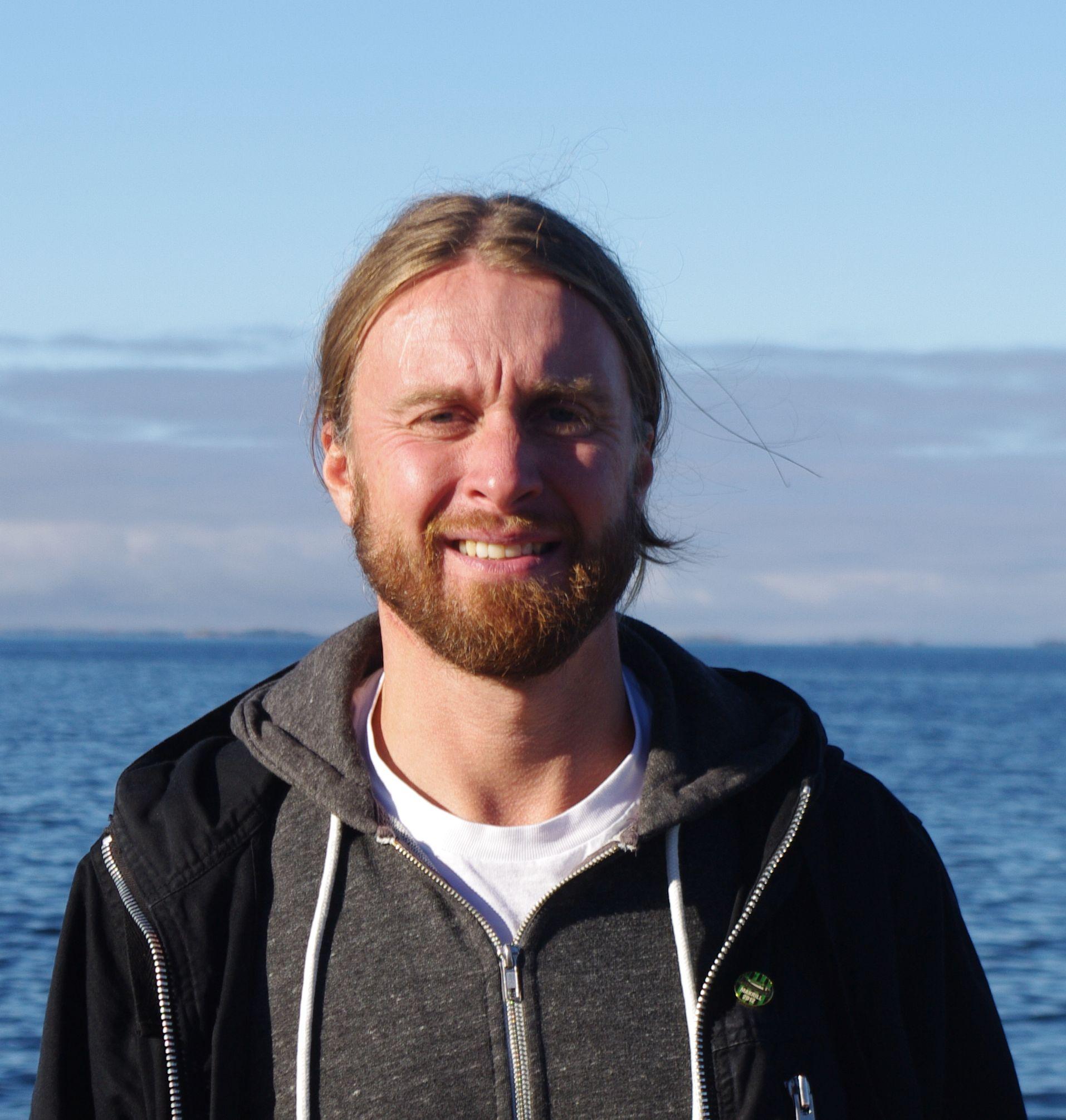
Jens Olsson
Chair of EG Coastal Fish
Swedish University of Agricultural Sciences
jens.olsson@slu.se
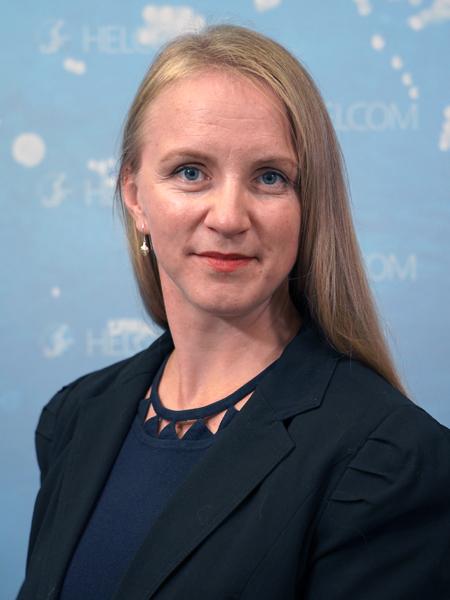
Lena Avellan
Professional Secretary
HELCOM Secretariat
lena.avellan@helcom.fi
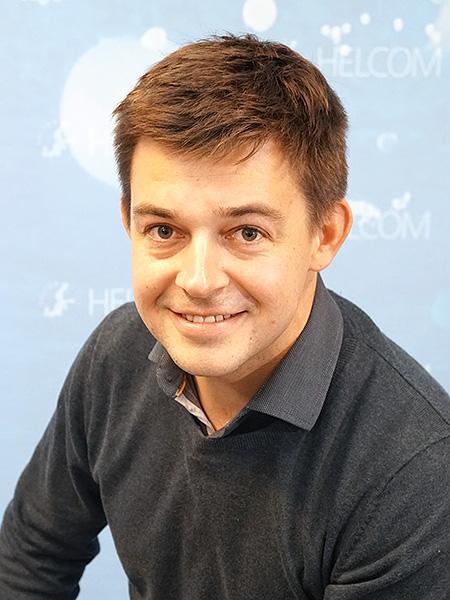
Florent Nicolas
Associate Professional Secretary
HELCOM Secretariat
florent.nicolas@helcom.fi
Latest related content
PUBLICATION (04/10/2024) Status of coastal fish communities in the Baltic Sea 2016-2020 – the fourth thematic assessment
PUBLICATION (23/09/2024) Guidelines for monitoring of phytoplankton species composition, abundance and biomass
PUBLICATION (28/03/2024) Baltic Stakeholder Conference 2024 report – PROTECT BALTIC
New criteria for sustainable aquaculture are a best practice example from HELCOM
HELCOM has officially unveiled the comprehensive Best Available Technologies (BAT) and Best Environmental Practices (BEP) for sustainable aquaculture in the Baltic Sea region, marking the culmination of extensive and constructive efforts. Helsinki Convention, governed by HELCOM, is the first Regional Seas Convention in Europe that has such specific guidance on aquaculture and can be regarded as a best practice example.
The balance between protection of the highly sensitive and strained Baltic Sea marine environment and the needs of the growing aquaculture sector was challenging to negotiate, but the successful and ambitious BAT/BEP descriptions give thorough and concrete guidance for both marine and freshwater aquaculture.
The pioneering BAT/BEP document is highly detailed, and it covers a wide range of issues, from inputs of nutrients and hazardous substances to marine litter, non-indigenous species and escapees, underwater noise, sustainable feed and feeding practices, as well as permits, monitoring and staff training. For instance, aquaculture can be a source of hazardous substance inputs through veterinary medicinal products, antifouling coatings, and cleaning and disinfection products. Concerning nutrient inputs, the key reason for eutrophication in the Baltic Sea, BAT/BEP descriptions recommend to set discharge limits that take account of the nutrient reduction scheme of HELCOM and the goals of the Baltic Sea Action Plan.
A regular reporting process aims to secure that HELCOM Contracting Parties apply the guidelines in their aquaculture operations.
The new BAT/BEP descriptions help to ensure that the growing aquaculture sector develops sustainably in the Baltic Sea.
BAT/BEP descriptions of sustainable aquaculture in the Baltic Sea region
Contact
Johanna Laurila
Communication Advisor, HELCOM
+358 40 6473996
HELCOM Explorer gives easy online access to follow implementing the Baltic Sea Action Plan
The recently updated online tool HELCOM Explorer allows to easily see how HELCOM cooperation bears fruit, and how the countries’ actions are being fulfilled when reaching the majority of their ambitious HELCOM targets and the ultimate goal: Baltic Sea in good ecological state.
The actions listed in the Explorer include the entire updated Baltic Sea Action Plan (2021), HELCOM Ministerial Meeting commitments from 2010 onwards as well as selected HELCOM Recommendations. The updated BSAP contains 199 concrete actions and measures addressing biodiversity, eutrophication, hazardous substances, and sea-based activities such as shipping and fisheries. In addition, it includes new actions on emerging or previously less highlighted pressures such as climate change, marine litter, pharmaceuticals, underwater noise, and seabed disturbance.
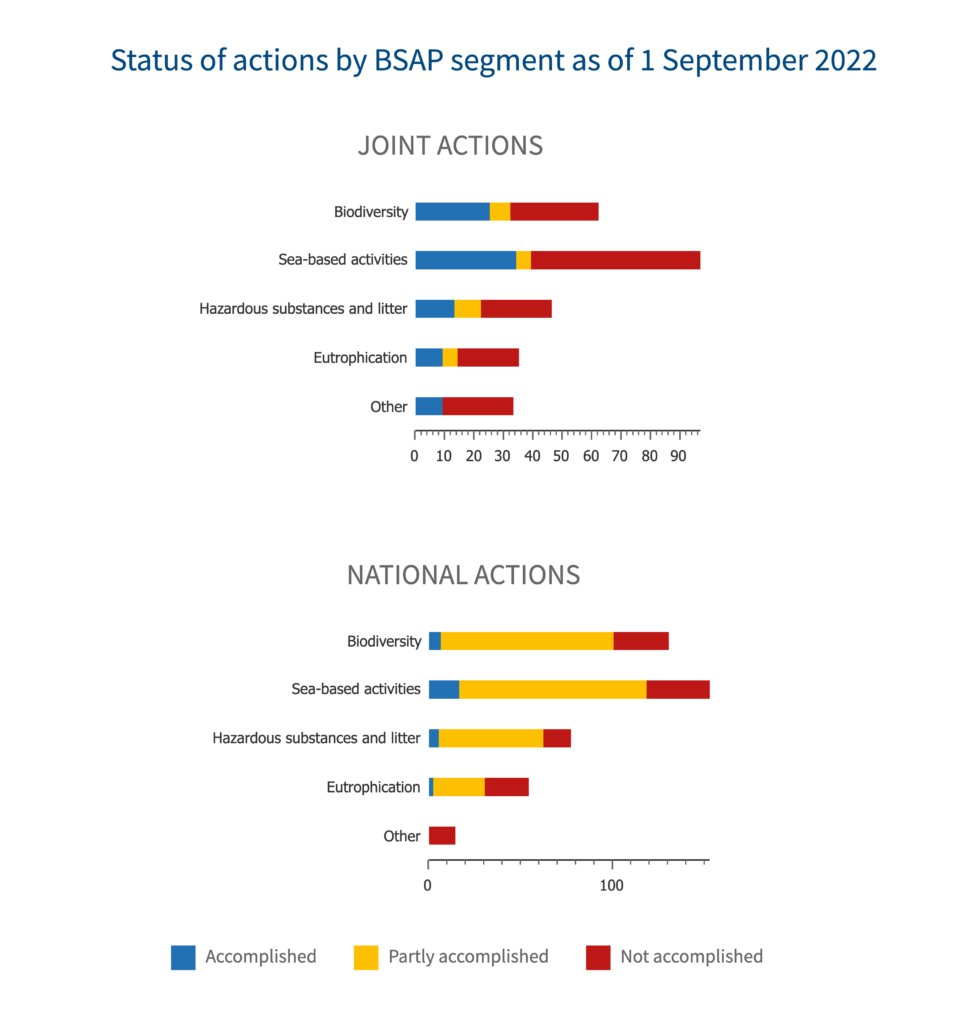
The updated BSAP is also closely aligned with international and regional objectives such as the UN Sustainable Development Goals (SDGs), the targets of the Convention on Biological Diversity (CBD), or, for those of our Contracting Parties that are also EU members, the EU’s Marine Strategy Framework Directive (MSFD). All actions are to be implemented by 2030 at the latest.
“As the HELCOM Explorer provides a comprehensive overview and a great amount of information on both joint and national actions, with easy filtering tools, it is quite a unique system in regional marine governance. Moreover, it is a very concrete indicator of transparency for our stakeholders and to the broader audiences”, says Rüdiger Strempel, Executive Secretary of HELCOM.
Joint actions are carried out together by all HELCOM Contracting Parties, for example creating a new Recommendation, joint management guidelines, or assessments of environmental status. National actions are implemented at the country level, and they include e.g. incorporating the provisions of a HELCOM Recommendation into relevant national legislation or guidelines.
The Explorer allows for easy overview browsing, but also for more detailed filtering, according to the details of the actions in the Baltic Sea Action Plan such as segment, theme, or target year. The tool further provides information on why the action is needed (rationale), what pressures or activities are addressed by the action in question, and, for some, what is the potential effect of the measure to reduce pressures or improve the state of the Baltic Sea. All data is available for download.
The HELCOM Explorer tool to track the progress on the implementation of HELCOM commitments was first launched in 2016, and the interface was updated in 2020.
The reporting on the implementation of the joint actions is done by relevant HELCOM Working Groups and the reporting on the national actions by the countries. The first reporting on the implementation of actions in the 2021 BSAP is planned to take place in 2025, followed by the second reporting round in 2029.
Contact
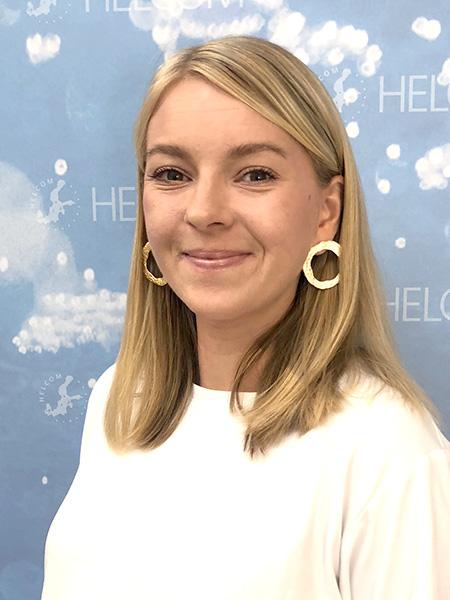
Laura Kaikkonen
Project Researcher
laura.kaikkonen@helcom.fi
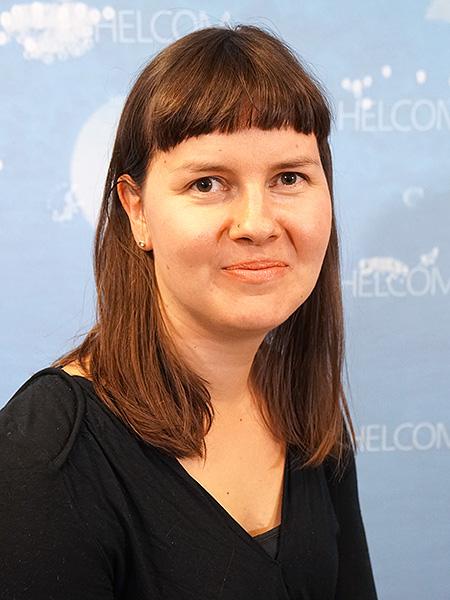
Susanna Kaasinen
Associate Professional Secretary
susanna.kaasinen@helcom.fi
About the Baltic Sea Action Plan (BSAP)
The Baltic Sea Action Plan (BSAP) is HELCOM’s strategic programme of measures and actions for achieving good environmental status of the sea, ultimately leading to a Baltic Sea in a healthy state.
Initially adopted by the HELCOM Contracting Parties in 2007, the 2021 BSAP is based on the original plan and maintains the same level of ambition. It also retains all actions previously agreed on that are still to be implemented, while, in addition, includes new actions to strengthen the existing efforts and tackle emerging concerns.
Guided by the HELCOM vision of “a healthy Baltic Sea environment with diverse biological components functioning in balance, resulting in a good ecological status and supporting a wide range of sustainable economic and social activities”, the updated BSAP is divided into four segments with specific goals: biodiversity, eutrophication, hazardous substances and sea-based activities.
About HELCOM Recommendations
One of the most important duties of the Helsinki Commission is to make Recommendations on measures to address certain pollution sources or areas of concern. Since the beginning of the 1980s HELCOM has adopted some 260 HELCOM Recommendations for the protection of the Baltic Sea. The implementation of various HELCOM recommendations by the HELCOM Contracting Parties plays an important role in achieving the objectives of the Baltic Sea Action Plan. The HELCOM Explorer covers the reporting on the implementation status of selected HELCOM Recommendations.
About HELCOM
The Baltic Marine Environment Protection Commission – also known as the Helsinki Commission (HELCOM) – is an intergovernmental organization (IGO) and a regional sea convention in the Baltic Sea area, consisting of ten members: the nine Baltic Sea countries Denmark, Estonia, Finland, Germany, Latvia, Lithuania, Poland, Russia and Sweden, plus the European Union. A platform for environmental policy making at the regional level, HELCOM works for a healthy Baltic Sea. Its mandate stems from a regional treaty, the Helsinki Convention, whose implementation it oversees. The HELCOM Secretariat is located in Helsinki, Finland.
HELCOM publishes maps on fish habitats
HELCOM just published several maps on essential fish habitats, publicly available online on HELCOM’s Map and Data service. The maps were produced under the recently concluded Pan Baltic Scope project on maritime spatial planning (MSP) in the Baltic Sea region and to which HELCOM was a partner.
The maps show potential spawning areas of cod, sprat and herring, which are the commercially most important fish species in the Baltic Sea region, as well as key areas for European and Baltic flounder, perch and pikeperch.
“With the maps on essential fish habitats, we now have another tool at our disposal to identify and evaluate marine areas of greater ecological importance,” said SLU Aqua’s Lena Bergström who was responsible for this component within the Pan Baltic Scope project.
Combined with corresponding data for other ecosystem components, the maps on essential fish habitats can be used to identify regions of high ecological value and areas which have the potential to deliver various essential ecosystem services.
The maps can be found under Biodiversity section of the HELCOM Map and Data service:
- Potential spawning areas for cod
- Potential spawning areas for Baltic flounder
- Potential spawning areas for European flounder
- Potential nursery areas for flounders
- Potential spawning areas for herring
- Potential spawning areas for sprat
- Potential recruitment areas for perch
- Potential recruitment areas for pikeperch
The maps can also be downloaded as raster files from the HELCOM Metadata catalogue.
The Pan Baltic Scope project was co-founded by the European Maritime and Fisheries Fund of the European Union. In the project, HELCOM notably collaborated on a data sharing activity to support regional cooperation and transboundary coherence in MSP which lead to the development of BASEMAPS, a web-based tool showing decentralized MSP data through open standard services.
Sea trout are back in Lithuanian river after successful restoration under the RETROUT project

©Piotr Wawrzyniuk – stock.adobe.com
Sea trout are reproducing again in parts of the Smeltalė river in Lithuania after a successful restoration exercise under the Baltic-wide RETROUT project.
“We counted 13 new sea trout nests within only two months after the restoration work was finished,” said Nerijus Nika from Klaipeda University, one of the partners responsible for the Lithuanian river restorations within RETROUT, further noting that the specifically created reproduction sections, or spawning habitats, were all intensively used by sea trout. The restoration work was completed in September 2019.
RETROUT carries out a number of river restoration demonstration cases in the project partner countries to improve the condition of sea trout populations.
“For viable and healthy sea trout populations, we need healthy and accessible rivers. Unfortunately, many rivers potentially suitable for sea trout aren’t yet in the condition we’d like them to be,” said Henri Jokinen, the RETROUT project manager at HELCOM.
In Lithuania, the rehabilitation started with the creation of a system of meandering shallow ponds in an area of the Smeltalė river previously purposed as a surface flow treatment wetland for improved water quality.
Since its construction 20 years ago, the wetland hadn’t been maintained, accumulating excessive sediments from defaulting sedimentation ponds as well as suffering from excessive vegetation on its banks.
In addition, a 500 m section was modified in the Smeltaitė stream, a main tributary of Smeltalė river, using stones, gravel and logs to create three 50 m long spawning and juvenile rearing habitats.
“According to local experts, such habitats are spawning hot spots for salmonids and lampreys in lowland streams of Lithuania,” said Jokinen. Indeed, all three created spawning habitat sections were intensively used by sea trout only two months after completion.
In the Smeltaitė stream, the two biggest trout nests – of 7,5 m2 and 10 m2 – were found in the restored stretch, in habitats pre-evaluated to be of high priority for sea trout females. One of these sites was constantly occupied for 1.5 month by up to five different trout, a rather unusual spawning behaviour.
With special focus on sea trout, the RETROUT project seeks to promote and develop sustainable coastal fishing tourism in the Baltic Sea region. RETROUT initiated 15 restoration cases in coastal rivers of Estonia, Lithuania, Latvia, Poland and Sweden. Measures under the project cover fishways, biotope restorations, water quality improvement, and dam removal plans.
In the RETROUT project, HELCOM leads the work package on Assessment of status and management of sea trout rivers and stocks which focuses mainly on the ecological aspect of trout fishing, notably through assessing fish stock and river habitat status, and by evaluating river restoration practices to improve trout populations.
The main results will be published as an assessment report and as a toolbox of best practices and guidelines for river restoration in the Baltic Sea.
“In addition to improving the actual condition of a river, the experience we get from these demonstration cases will help us to develop the ‘Guidelines for river restoration best practices in the Baltic Sea region,’ another major outcome of the project,” said Jokinen.
The restoration of the Smeltalė river was conducted by the Klaipeda District Municipality Administration, with technical and scientific support from the Klaipeda University.
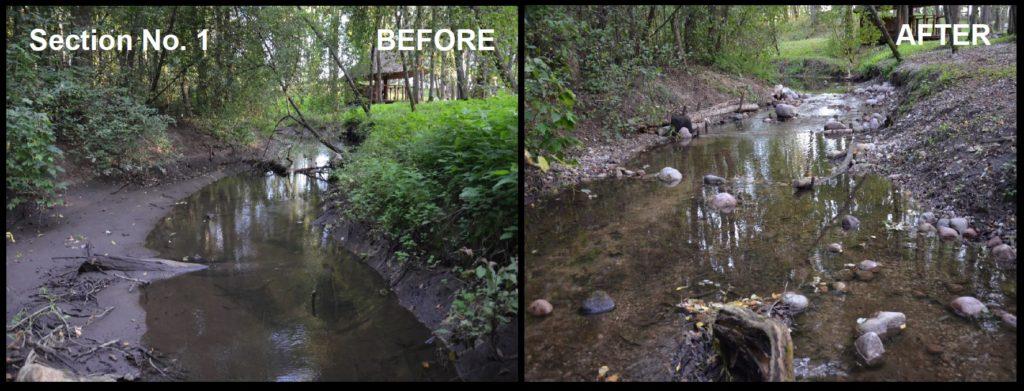
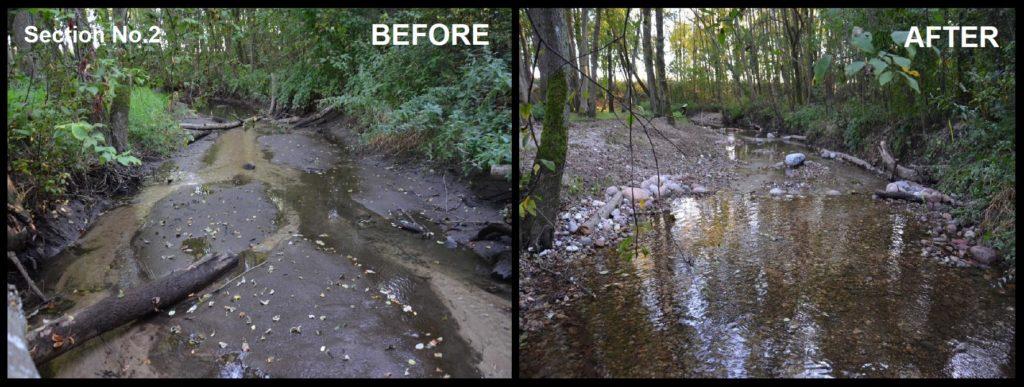
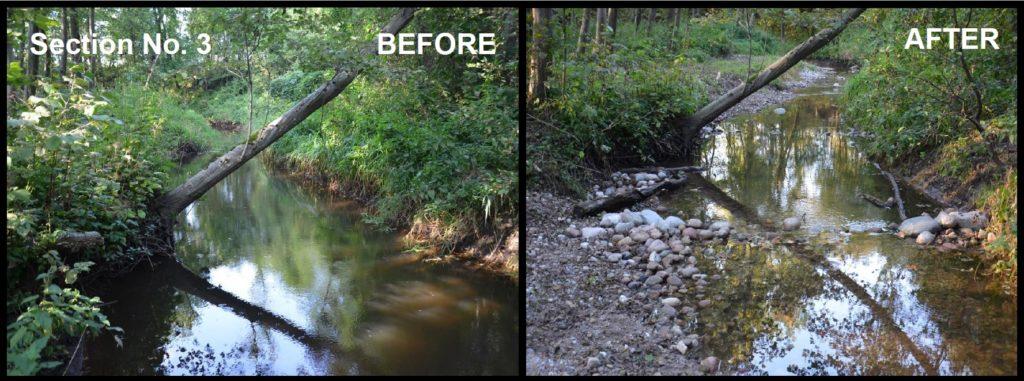
Photos from Smeltalė river, Lithuania. © Nerijus Nika
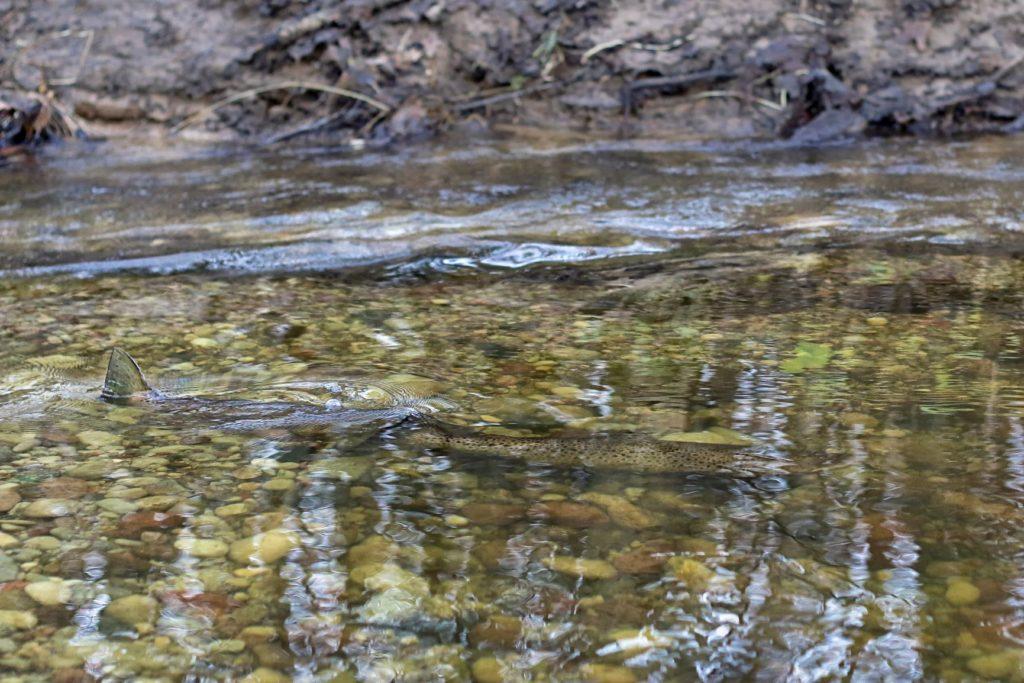
Two sea trout in their newly restored habitat. © Tomas Ruginis
Bye-bye bycatch: HELCOM and OSPAR are pooling efforts to deal with incidental catch of species

To better understand incidental bycatch of marine mammals and seabirds due to fishing, HELCOM and its sister organization from the North Sea, OSPAR, held a joint workshop in Copenhagen, Denmark from 3 to 5 September 2019.
Bycatch has been identified as a serious pressure on several species in both the North and Baltic Seas. According to estimates published in the HELCOM State of the Baltic Sea report, up to 200,000 seabirds drown annually in both seas, trapped in fishing gear.
The report further indicates that only 500 harbour porpoises and 100 ringed seals are estimated to remain in the Baltic Proper – the central part of the Baltic – and the eastern part of the Gulf of Finland respectively. Bycatch is therefore a major threat to these already low populations.
“The North and Baltic Seas have a direct ecological connection, with species freely moving between the two basins,” said Jannica Haldin, the HELCOM Professional Secretary in charge of biodiversity, further stressing that a common approach is essential to effectively address the bycatch issue.
By the same token, the workshop paved the way towards a proposal for joint conservation objectives on incidental bycatch between the two sister seas, which may further lead to the development of a common regional indicator on bycatch applicable in both areas.
HELCOM already has its own indicator on bycatch – Number of drowned mammals and waterbirds in fishing gear – which currently makes a descriptive evaluation of whether the number of drowned marine mammals and seabirds are below the level considered to reflect sustainable levels.
In addition to benefitting the countries that are members of both HELCOM and OSPAR, namely Denmark, Germany and Sweden, a joint approach on bycatch would also facilitate the national efforts of EU countries to assess the mortality rate from incidental bycatch per species as set by the EU’s Marine Strategy Framework Directive (MSFD).
In Copenhagen, it also became clear that more data on small fishing vessels is urgently needed. Unlike larger vessels, small boats are currently not generally required to report on their fishing activities, complicating bycatch assessments.
“Small vessels make up a large part of the fisheries in the Baltic Sea. Due to their lower capacities they tend to operate closer to the coast, which is also where many seabirds forage. This overlap leads to a higher likelihood of bycatch, often amplified by the type of fishing gear commonly used by smaller boats such as gillnets,” said Haldin.
During the workshop, it was suggested that mapping high-risk areas can help guide effective assessment of bycatch.
“Overlaying fishing data with species distribution and abundance can provide a good indication on where bycatch is likely to happen,” said Owen Rowe, the HELCOM project manager on indicators, adding that a solid risk assessment could help minimize bycatch.
The results of the workshop will now be considered at the respective working group levels in HELCOM and OSPAR. At HELCOM, the findings will further feed into the preparations of the next holistic assessment of the Baltic Sea, HOLAS III.
Halfway there: RETROUT project for promoting sustainable fishing and viable fish stocks convenes for its mid-term meeting
The project had its mid-term meeting in Gdańsk, Poland from 8 to 9 May
2019, looking at achievements so far and the next steps to be taken. “Work is progressing according to plans,
although some challenges need to be tackled to reach the final goals by the end
of the project in fall 2020,” said Håkan Häggström, the RETROUT from the County Administrative
Board of Stockholm, Sweden. With special focus on sea trout, RETROUT
seeks to promote and develop sustainable coastal fishing tourism in the Baltic
Sea region. Fostering thriving fish populations is a key approach of the
project, through enabling healthy and accessible river habitats for the natural
reproduction of sea trout that will eventually lead to a larger stock size. In the countries where it operates, the
project also carries out a number of river restoration initiatives to improve the
condition of sea trout populations. For example, one case study will focus on
the renewal of the riverbed to increase nursery areas, while another project is
working on building a new fish pass to facilitate the free movement of fish
past migration obstacles. “For healthy trout populations, rivers need
to be protected and restored, for instance by removing migration hindrances and
improving spawning grounds. We need to increase the efforts for securing
self-sustaining and viable populations of migratory fish in the Baltic Sea”,
said Henri Jokinen, the RETROUT Project manager at HELCOM. In Gdańsk, HELCOM chaired the second day
work group session for the RETROUT work package on ‘Assessment of status and
management of sea trout rivers and stocks.’ This focuses mainly on the ecological
aspect of trout fishing, notably through assessing fish stock and river habitat
status, and by evaluating river restoration practices to improve trout
populations. The main results will be published as an assessment report and as
a toolbox of best practices for river restoration in the Baltic Sea. “So far, we have had a very useful workshop
about sea trout assessment and monitoring methods last year, we have collected
a nice data set of past river restoration cases and conducted a valuable amount
of stakeholder interviews to learn about factors of success and failure in
river restoration projects, and we advanced with the river restoration
demonstration projects carried out in the project countries, to mention some of
the achievements. We are in a good place to start on the next half of the
project,” said Jokinen. The HELCOM-led work in RETROUT is in line
with the on salmon and
sea trout, and supports the ‘Conservation of
Baltic Salmon (Salmo salar) and Sea Trout (Salmo trutta)
populations by the restoration of their river habitats and management of river
fisheries’. In essence, the RETROUT project aims to
stimulate sustainable economic and social development based on healthy
ecosystems, reflecting the general HELCOM priorities.With 14 partners from Sweden, Estonia,
Latvia, Lithuania and Poland, and including HELCOM, RETROUT is a three-year Interreg
project running until September 2020. RETROUT is a flagship project of the EU
Strategy for the Baltic Sea Region . It is co-financed by the under the Natural resources
priority field. –For
more information:Henri
Jokinen
RETROUT Project manager
henri.jokinen@helcom.fi
The RETROUT project had its mid-term meeting in Gdańsk, Poland from 8 to 9 May 2019, looking at achievements so far and the next steps to be taken.
Coastal fish assessments will continue in the Baltic Sea with renewed HELCOM project
Members of the FISH-PRO III project in Helsinki on 13 February 2019. © HELCOMCoastal fish assessments will continue to be carried out in the Baltic Sea with renewed commitment from the HELCOM countries, as shown during the first meeting of the that was held in Helsinki from 12 to 14 February 2019. The focus of the meeting was to finalize the revised monitoring guideline for coastal fish in HELCOM, and to follow up on the development work of the indicators used for the assessments of coastal fish.”The Helsinki meeting took us a step further in the development of additional indicators for coastal fish,” said Jens Olsson, project manager of FISH-PRO III and chair of the meeting.The current on coastal fish notably evaluate the abundance of typical species of fish, such as perch and flounder, in the coastal areas of the Baltic Sea. They also evaluate the status of key functional groups such as piscivores, cyprinids and mesopredators.FISH-PRO III – the Continuation of the Project for Baltic-wide assessment of coastal fish communities in support of an ecosystem-based management – follows the FISH-PRO II project. Findings from FISH-PRO II were recently published in the . HELCOM thematic assessments on coastal fish have been produced since 2006. Attended by participants from Denmark, Estonia, Finland, Latvia, Lithuania, Poland, Russia and Sweden, the meeting was instrumental in outlining the project’s thematic areas of work and workplan for the coming years. Furthermore, the assessments produced by FISH-PRO III will also feed the .
Coastal fish assessments will continue to be carried out in the Baltic Sea with renewed commitment from the HELCOM countries, as shown during the first meeting of the FISH-PRO III project that was held in Helsinki from 12 to 14 February 2019.
Mapping of essential fish habitats gets underway in joint HELCOM-Pan Baltic Scope workshop
Experts in marine biology and maritime spatial planning came together in Riga from 12 to 13 December in a workshop addressing essential fish habitats in the Baltic Sea, with the goal to map the most significant areas.
“We want to see where the important fish habitats are in the Baltic Sea,” said Lena Bergström from HELCOM who co-organized the workshop together with Latvia, adding that the maps will be a useful tool for better informed maritime spatial planning (MSP).
During the workshop, participants validated the proposed essential fish habitats maps, and provided recommendations for their further use in HELCOM. The maps will eventually be made available to maritime spatial planners as well as other users on HELCOM’s website.
Essential fish habitats are – as their name suggests – essential for the healthy development of fish during their entire life cycle, from spawning, nursery and feeding to maturity. These habitats play an important role in the entire food web chain and marine ecosystem.
Since most fish species use different habitat types for different periods of their life cycle, the workshop notably focussed on describing different categories such as spawning areas, nursery areas for larvae and juveniles, adult feeding areas, and migratory corridors.The information presented during the workshop will be further used in the , to develop a concept of for supporting maritime spatial planning in the HELCOM region.
A novelty in MSP, green infrastructure seeks to promote an ecosystem-based approach in maritime spatial plans that also integrates the ecosystem services rendered by the marine environment – the free benefits we humans gain from a sea in a healthy state. The workshop was co-organised by HELCOM and the Pan Baltic Scope project, and hosted by the Latvian Ministry of Environment.
Experts in marine biology and maritime spatial planning came together in Riga from 12 to 13 December in a workshop addressing essential fish habitats in the Baltic Sea, with the goal to map the most significant areas.
HELCOM report on coastal fish in the Baltic Sea finds that only half of the assessed areas are in a good state
HELCOM recently published a report assessing coastal fish in the Baltic, the . According to the report, only about half of the assessed areas obtain a good status.In general, the overall status of varies between geographical areas, with the north of the Baltic faring slightly better than the south. Key species and piscivores show a better status in more northern areas of the Baltic, compared to the south of the sea. For cyprinids, the status is often insufficient due to overabundance, especially in the north-eastern part of the Baltic. “The report summarizes the current status of coastal fish communities in the Baltic Sea as derived from official monitoring programs of the ,” said Jens Olsson from the Swedish University of Agricultural Sciences and who led the report. “It also contains short reviews on the factors regulating the communities and potential measures for the restoration and protection of coastal fish in the Baltic Sea.”To date, measures to restore and support coastal fish communities have barely been evaluated. As highlighted in the report, fishing regulations including permanent or temporary no-take areas, gear regulations, and habitat protection and restoration are measures that have shown to have a positive effects on fish populations.Coastal fish communities are regulated by a plethora of both natural and human-induced factors such as fishing, habitat exploitation, climate, eutrophication and interactions between species in the ecosystem.In being in the central part of the food-web, coastal fish are of key ecological and socio-economic importance, and their status often reflects the general health of coastal ecosystems.Depending on the sub-basin, the assessed key species were mainly perch and, in some southern areas, also flounder. The monitored piscivorous fish were perch, pike, pike-perch, burbot, cod and turbot. In the cyprinid family, roach and breams dominated the catch assessed. In the few areas where cyprinids do not occur naturally, mesopredatory fish were assessed instead, such as wrasses, sticklebacks, flatfishes, clupeids and gobies.”The information contained in this report is a valuable basis for following up on the objectives of the and , as well as for the development of national management plans for coastal fish,” concluded Olsson. –For more information:Jens OlssonSwedish University of Agricultural Sciences (SLU Aqua)jens.olsson@slu.se
HELCOM recently published a report assessing coastal fish in the Baltic. According to the report, only about half of the assessed areas obtain a good status.

